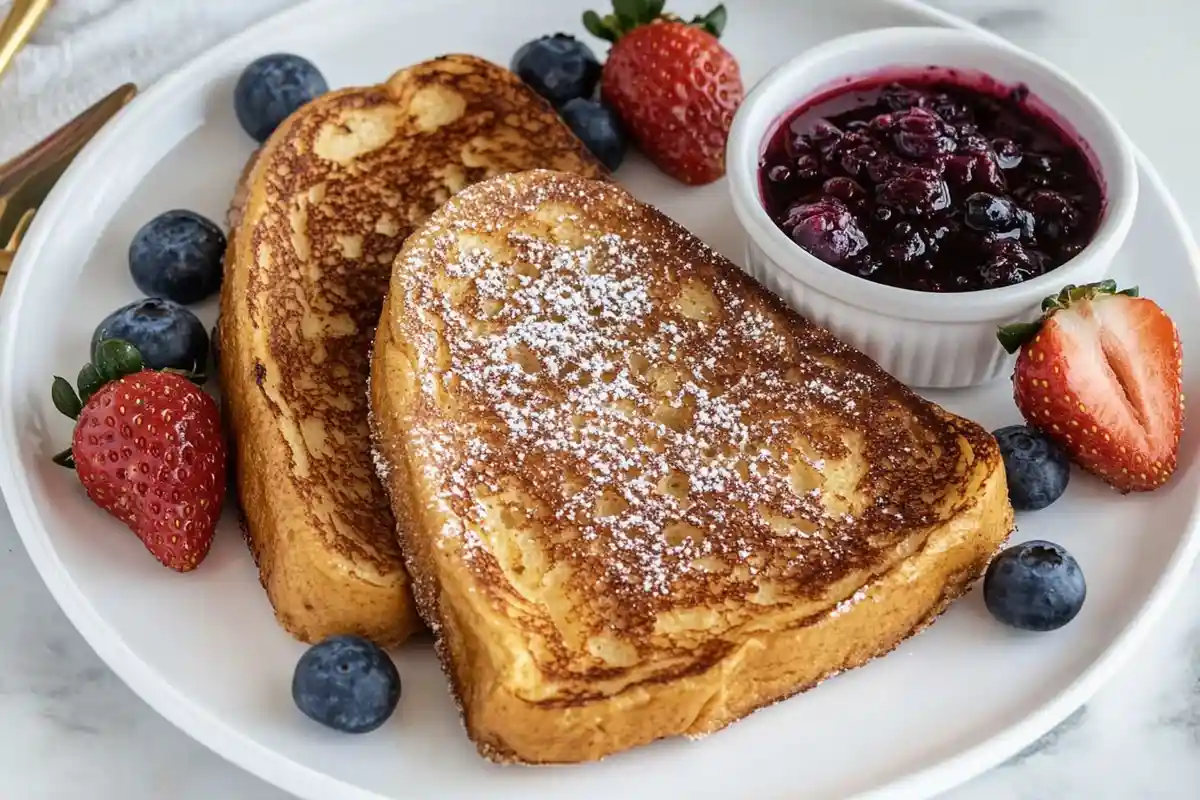Ah, French toast! It’s a breakfast staple that holds a special place on tables worldwide. But when you swap out ordinary bread for the tangy, chewy goodness of sourdough, this classic dish transforms into something truly unforgettable. Whether planning a fancy brunch or a lazy Sunday breakfast, Sourdough French Toast is always a winner.
This article will guide you through everything you need to know to make the perfect sourdough French toast. You’ll learn everything from choosing the best ingredients and mastering the recipe to creative variations and tips for making it unforgettable. By the time you’re done reading, you’ll be ready to create this heavenly dish and have answers to common questions about why sourdough works so well. So, grab your skillet and dive into Sourdough French Toast’s delightful world!
Table of Contents
Introduction to Sourdough French Toast
Regarding breakfast comfort food, French toast is probably high on the list. But what sets sourdough apart when making this dish? Sourdough bread’s unique flavor and hearty texture make it an unexpected—but perfect—choice for elevating traditional French toast. With its slightly tangy taste, airy interior, and crisp crust, sourdough creates a sophisticated and satisfying balance.
What is Sourdough French Toast?
Put simply, Sourdough French Toast is a twist on the classic recipe, swapping regular bread for sourdough. The result? A dish with deeper flavors and a texture that holds up beautifully to the rich, custard-like batter. Sourdough is made with a natural fermentation process, giving it its signature tanginess and making it more nutrient-dense and easier to digest than other breads.
Whether you’re a fan of sweet breakfasts or lean more toward savory flavors, sourdough French toast has something for everyone. It pairs well with traditional toppings like powdered sugar and syrup but can also handle bold additions like fresh fruit, yogurt, or even poached eggs.
Why Sourdough Bread Makes the Perfect French Toast
Sourdough works so well in French toast because of its texture. Unlike softer bread that can turn mushy, sourdough’s firm, chewy crumb soaks up the egg mixture without falling apart. Its tangy flavor adds complexity to the dish, complementing sweet toppings beautifully.
Compared to popular alternatives like brioche or challah, sourdough offers a rustic charm and versatility. While brioche is rich and buttery, and challah is soft and slightly sweet, sourdough brings a heartier, more artisan feel. It’s ideal for those who love bold flavors and a bit of bite in their French toast.
A Timeless Favorite with a Twist
French toast has been enjoyed for centuries, dating back to ancient Rome. It’s a dish that transcends cultures and traditions, but incorporating sourdough bread gives it a modern twist. Whether served at upscale brunch spots or as a homemade treat, sourdough French toast proves that sometimes, you only need a small change to make a big impact.
Ingredients and Preparation
Choosing the Best Ingredients
Creating a flawless Sourdough French Toast starts with picking the right ingredients. Every bite should be a mixture of flavors and textures, so you can’t skimp on quality! Each component plays a crucial role in turning a simple breakfast dish into an unforgettable experience from the bread to the batter.
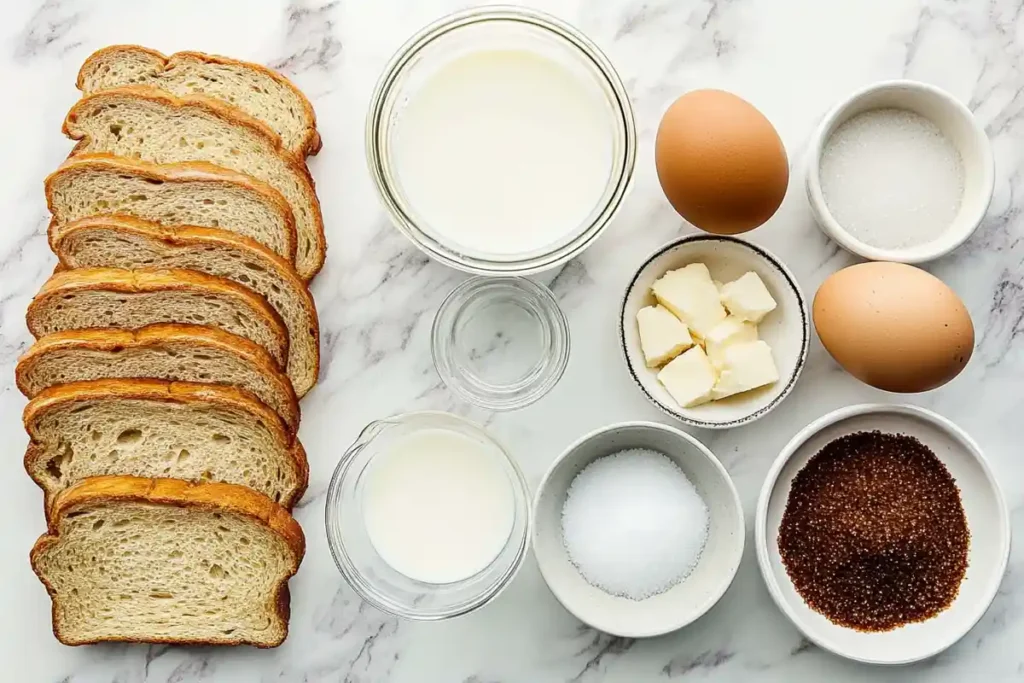
The Importance of Quality Sourdough Bread
The star of the show here is, of course, sourdough bread. But not just any sourdough will do. Aim for bakery-fresh or even homemade sourdough with a firm crust and a chewy interior for the best results.
- Why stale bread works best: Slightly stale sourdough is ideal because it soaks up the batter like a sponge without becoming overly soggy. If your bread is fresh, let it sit out for a few hours or lightly toast it to mimic that firmness.
- Slice thickness matters: Too thin slices can fall apart, while overly thick slices may not cook evenly. Stick to about ¾-inch slices for the perfect balance.
If you’re feeling adventurous, experiment with flavored sourdough, like whole grain or rosemary, to add extra depth to your French toast.
Essential Ingredients for a Perfect Batter
The batter is the heart of your Sourdough French Toast. It’s where all the magic begins! A rich, creamy batter ensures that the bread gets infused with flavor while maintaining its structure. Here’s what you’ll need:
- Eggs: Eggs give French toast its signature custard-like texture. Aim for large, fresh eggs for the best results.
- Milk or cream: This is where the creaminess comes in. Whole milk works perfectly, but heavy cream or half-and-half can be used for a more decadent option. Want a lighter version? Try unsweetened almond milk or oat milk.
- Flavorings: A splash of vanilla extract and a sprinkle of ground cinnamon are non-negotiable for classic French toast. Nutmeg is a wonderful optional addition for a slightly spiced aroma.
- Sweeteners: If you like a touch of sweetness, add a teaspoon of honey, maple syrup, or sugar to the batter. However, this is optional—especially if you plan to drizzle syrup over the finished dish.
Optional Extras for Flavor Customization
Feel free to get creative! Add a pinch of salt to balance the sweetness, or stir in some orange zest for a citrusy twist. If you prefer a savory spin, omit the vanilla and cinnamon, and mix in a teaspoon of garlic powder or fresh herbs.
Step-by-Step Recipe for Sourdough French Toast
Now that you’ve gathered your ingredients, let’s dive into the step-by-step process of preparing the ultimate Sourdough French Toast. From prepping your bread to achieving golden-brown perfection, this guide will walk you through every detail.
Preparation of Sourdough Bread
Before dunking your bread into the batter, it’s important to prep it properly:
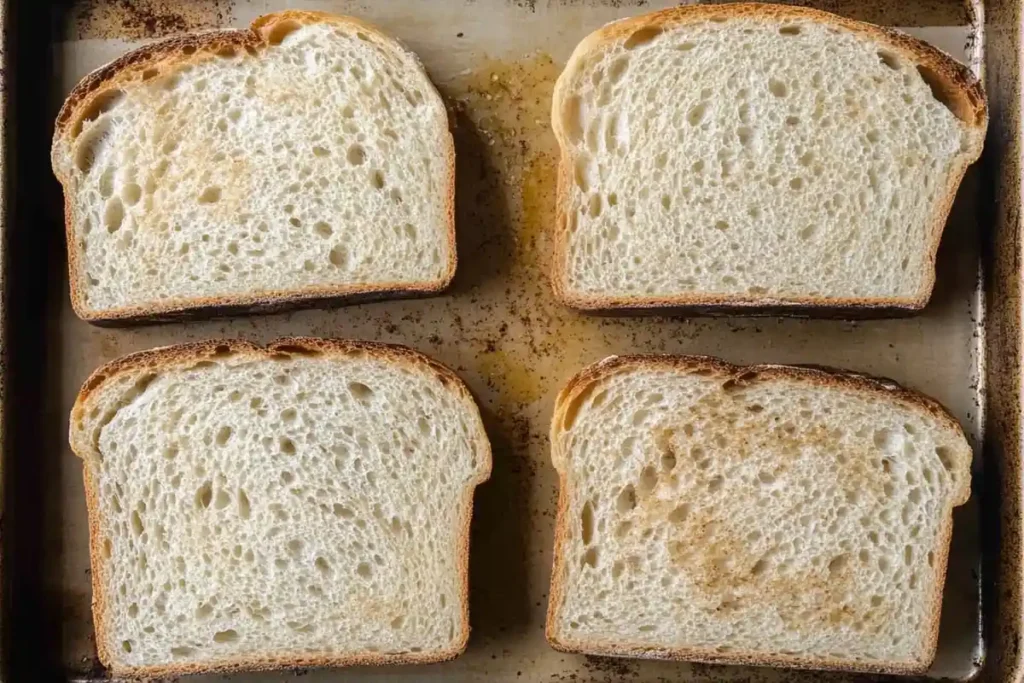
- Cut into even slices: Aim for uniform slices to ensure even cooking. Stick to ¾-inch thickness for the best texture.
- Use slightly stale bread: Fresh sourdough can sometimes be too soft, leading to soggy results. Letting it sit out for a day or two will help it absorb the batter better.
- Optional step: For an extra crunch, lightly toast the bread before dipping it into the batter.
Making the Perfect Batter
The batter is where the sourdough comes to life! Follow these steps for a flawless mixture:
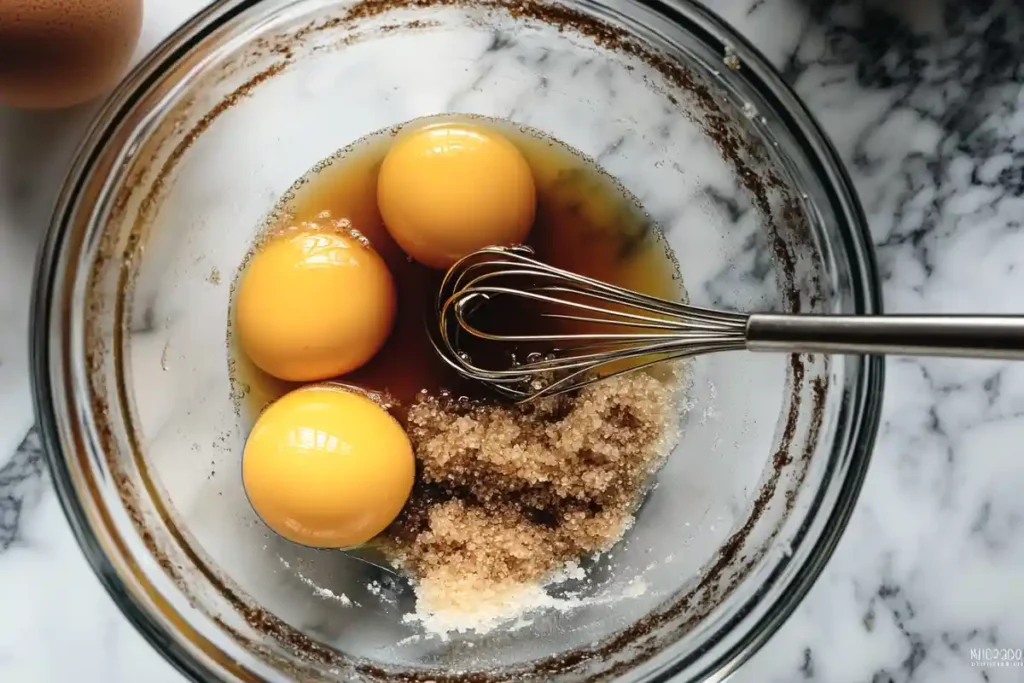
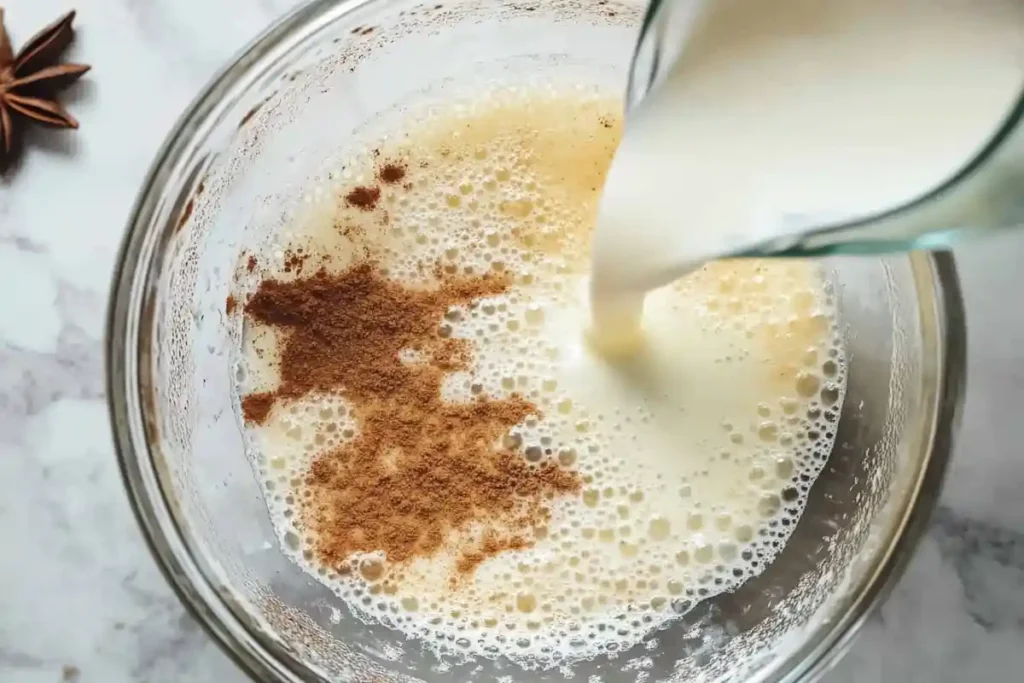
- Whisk together the wet ingredients: Crack your eggs into a mixing bowl and whisk them thoroughly to break them up. Gradually add in your milk (or cream) and whisk until smooth.
- Add the flavorings: Stir in vanilla extract, cinnamon, and any other spices or sweeteners you use. Whisk until the batter is well combined and slightly frothy.
Cooking Instructions
Cooking sourdough French toast to golden perfection is an art. Here’s how to do it right:
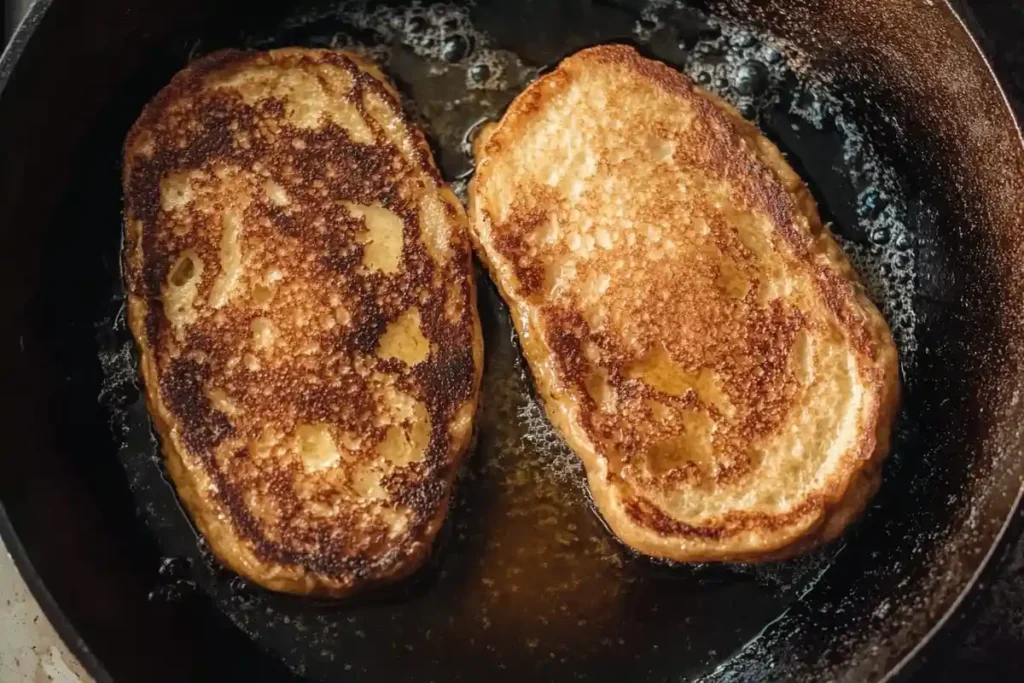
- Heat your pan: Use a non-stick skillet or a well-seasoned cast iron pan for the best results. Heat it over medium heat and melt a tablespoon of butter (or a mix of butter and oil for higher heat tolerance).
- Dip the bread: Quickly dunk each slice of sourdough into the batter, letting it soak for a few seconds on each side. Be careful not to over-soak, which can make the toast too soft.
- Cook to perfection: Place the soaked bread onto the hot skillet. Cook for 2-3 minutes on each side until golden brown. Adjust the heat as needed to avoid burning.
Serving Suggestions
Presentation is everything! Once your Sourdough French Toast is cooked to golden perfection, it’s time to plate and serve:
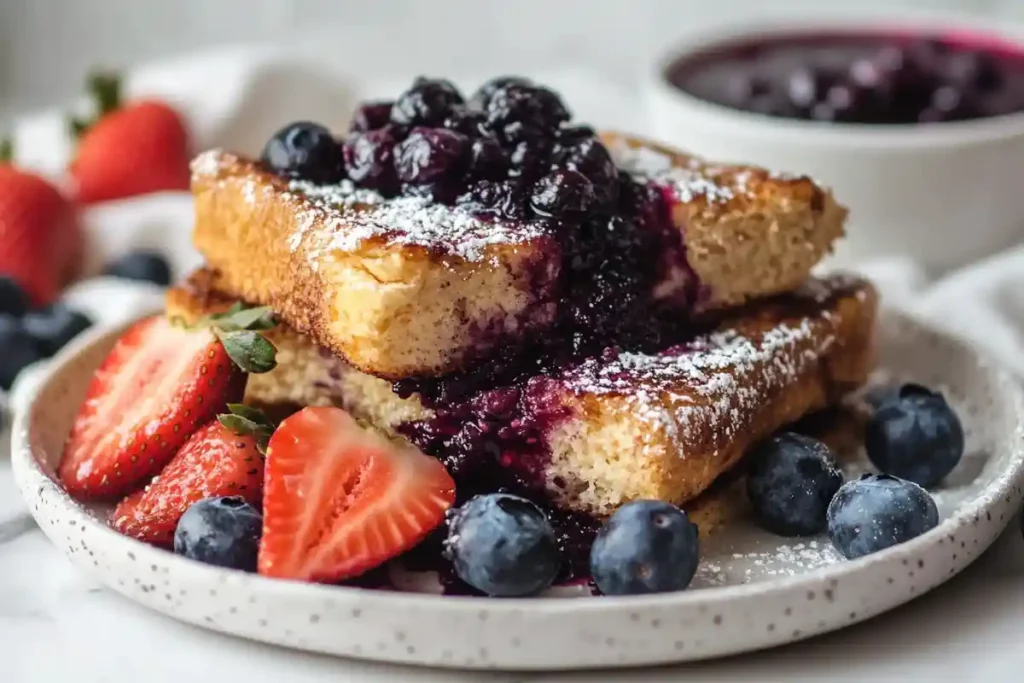
- Classic toppings: A dusting of powdered sugar and a drizzle of warm maple syrup never go out of style.
- Fruit and cream: Fresh berries, banana slices, or a dollop of whipped cream add a touch of freshness and color.
- Savory twist: For those who prefer savory flavors, top your toast with avocado slices, a fried egg, or crispy bacon.
Tips, Variations, and Pairings
Tips for Perfect Sourdough French Toast Every Time
Let’s face it: not all French toast turns out Instagram-worthy on the first try. But with a few simple tricks, you can elevate your Sourdough French Toast to gourmet status. Whether you’re a seasoned pro or a first-timer, these tips will help you nail it every time.
Avoiding Soggy Toast
One of the biggest pitfalls of French toast is sogginess. Sourdough’s dense texture helps combat this, but technique matters too:
- Don’t over-soak the bread: Quickly dip each slice into the batter, letting it absorb just enough to coat the surface without becoming waterlogged.
- Use slightly stale bread: Fresh bread tends to fall apart in the batter, while day-old sourdough has the perfect structure to soak up just the right amount of liquid.
- Cook at the right heat: Medium heat is your best friend. Too high, you’ll burn the outside while leaving the inside undercooked. Too low, and you’ll end up with limp, greasy slices.
Achieving That Golden-Brown Crust
The hallmark of great Sourdough French Toast is a perfectly crisp and golden exterior. To achieve this:
- Use butter—but not too much: A small pat of butter in the pan adds flavor and helps create a golden crust. However, too much butter can result in greasy toast.
- Don’t crowd the pan: Give each slice enough room to cook evenly. Crowding the skillet can lead to uneven browning.
- Flip carefully: Use a spatula to gently turn each slice when it’s golden brown on the bottom.
The Perfect Pan for French Toast
A non-stick skillet or a well-seasoned cast iron pan is ideal for cooking French toast. Both offer even heat distribution and prevent sticking, ensuring beautifully cooked slices every time.
Creative Variations of Sourdough French Toast
Bored of the same old French toast? Sourdough is incredibly versatile, making it the perfect canvas for creativity. These variations will inspire you to think outside the (bread) box.
Stuffed Sourdough French Toast
Why settle for regular French toast when you can stuff it with something decadent?
- Sweet fillings: Spread cream cheese, Nutella, or your favorite jam between two slices of sourdough before dipping them into the batter. The result? Gooey, indulgent perfection.
- Savory fillings: Add a layer of shredded cheese, spinach, or sautéed mushrooms for a hearty breakfast.
Savory Sourdough French Toast
French toast doesn’t always have to be sweet. For a savory twist, skip the vanilla and cinnamon in the batter and try these ideas instead:
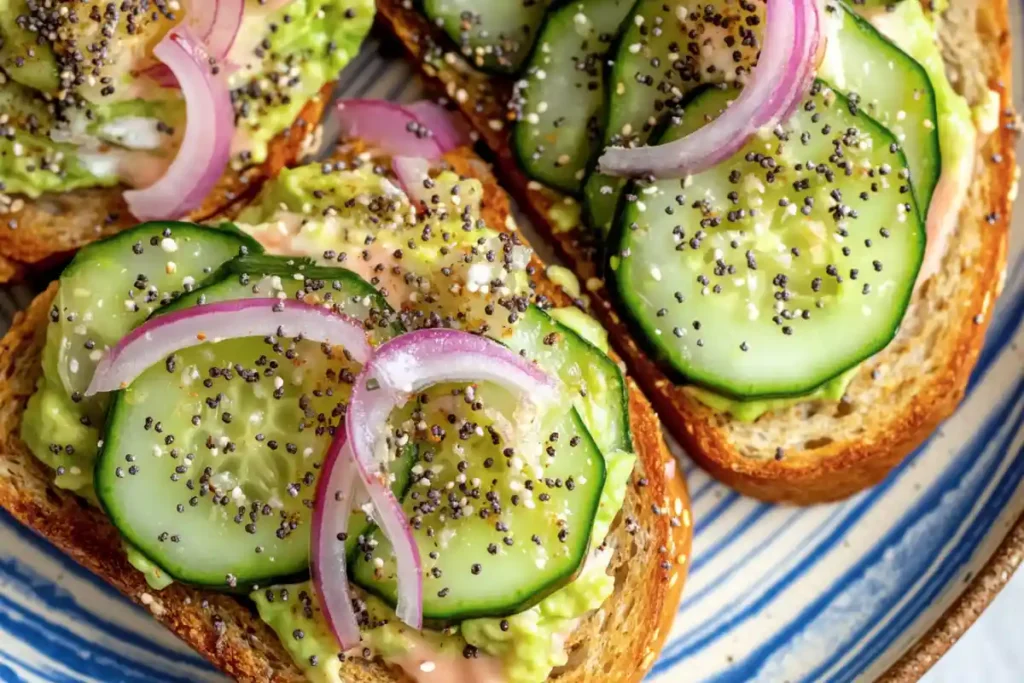
- Herbed batter: Add garlic powder, chopped parsley, and a pinch of paprika to your egg mixture for a savory flavor.
- Toppings: Top with avocado slices, poached eggs, or smoked salmon for a brunch-worthy meal.
Diet-Friendly Options
Want to make your Sourdough French Toast a little healthier? It’s easier than you think!
- Gluten-free sourdough: If you’re gluten-intolerant, look for gluten-free sourdough bread. It’s just as flavorful and perfect for French toast.
- Low-sugar batters: Replace sweeteners in the batter with natural alternatives like stevia or monk fruit.
- Dairy-free options: Use almond milk, coconut milk, or oat milk instead of dairy, and cook with coconut oil instead of butter.
Perfect Pairings for Sourdough French Toast
Pairing the right sides and beverages with your Sourdough French Toast can elevate your breakfast to a new level. Here are some ideas to complete your meal.
Beverage Pairings
The right drink can make all the difference in your breakfast experience:
- Coffee or tea: A freshly brewed cup of coffee or an aromatic chai tea is the ultimate pairing for the bold flavors of sourdough.
- Mimosas: For brunch, a light and bubbly mimosa complements the richness of the French toast perfectly.
- Fresh smoothies: A fruit smoothie made with bananas, berries, or mangoes adds a refreshing contrast to the dish.
Side Dish Ideas
French toast is already filling, but a few well-chosen sides can take it from great to exceptional:
- Savory sides: Crispy bacon, sausage links, or scrambled eggs balance out the sweetness of the toast.
- Fresh fruit: Serve with sliced strawberries, blueberries, or a simple fruit salad for a pop of freshness.
- Yogurt parfaits: Layer Greek yogurt with granola and fresh fruit for a healthy, complementary side.
Sourdough Bread and French Toast FAQs
Many people have questions when making Sourdough French Toast—especially if they’re new to using sourdough bread in recipes. From flavor comparisons to bread types, we’ll tackle some of the most common questions to help you become a sourdough French toast expert.
Does sourdough taste good for French toast?
Absolutely! Sourdough’s tangy flavor adds an exciting twist to traditional French toast. While most recipes use sweet or neutral bread, sourdough offers a depth of flavor that balances sweetness and pairs beautifully with toppings like maple syrup or fresh fruit. Its slightly chewy texture makes it a fantastic choice for soaking up custard without falling apart. Sourdough French toast is a game-changer if you’re a fan of bold, rustic flavors!
Is sourdough or brioche better for French toast?
It comes down to personal preference, but let’s break it down.
- Sourdough: Known for its chewy texture and tangy flavor, sourdough is ideal if you want a rustic, hearty French toast with a unique taste. It also works great for sweet and savory recipes, giving you more versatility.
- Brioche: Brioche, on the other hand, is soft, buttery, and slightly sweet. It’s perfect for those who want a rich and indulgent French toast. However, its delicate texture can sometimes become overly soft when soaked in batter.
In short, sourdough is the better choice if you’re looking for a robust and flavorful twist, while brioche is perfect for an ultra-decadent treat.
What is the best bread for French toast?
There’s no one-size-fits-all answer—it depends on what you’re going for! Here’s a quick comparison of the top contenders:
- Sourdough: Tangy, hearty, and great for soaking up the batter without getting soggy. Perfect for those who enjoy bold flavors.
- Brioche: Buttery and soft, ideal for a rich, dessert-like French toast.
- Challah: Slightly sweet and fluffy, similar to brioche but with a firmer texture.
- Whole grain bread: A healthier option with more fiber, though it may not soak up the batter and other types.
Each bread brings its unique qualities to the table, but sourdough stands out for its versatility and distinctive flavor.
Does sourdough bread make good toast?
Yes, sourdough bread is fantastic for toast—and that’s one of the reasons it shines in French toast recipes. Its crisp crust and chewy interior make it a great choice for simple buttered toast or more elaborate creations like avocado toast. When it’s used for French toast, sourdough holds up beautifully under the batter, giving you a crispy and soft dish on the outside.
If you’re loving the idea of Sourdough French Toast, why stop there? Take your sourdough adventures further with our delicious Sourdough Bread Pudding Recipe, or learn how to make soft and flavorful Sourdough Dinner Rolls. For dessert, try the indulgent Sourdough Chocolate Cookies. Feeling creative? Our easy Sourdough Discard Tortillas are perfect for savory dishes! Explore these recipes and more to make every meal unforgettable.

